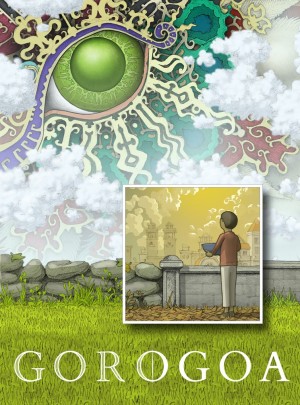Review for A Tale of Caos: Overture

After years of cutting its teeth designing free adventure games, indie Italian developer Expera Game Studio finally made the leap to its first commercial venture in 2017 with the release of A Tale of Caos: Overture. It’s plain to see that the experience the team gathered during their freeware years has not gone to waste, resulting in a lengthy, enjoyable and quite humorous traditional point-and-click experience stuffed to the gills with charming characters and well-implemented, often quite challenging inventory-based puzzles. As the title implies, however, this game is just the first entry in a larger story, and some threads are left unresolved by the time the credits roll.
Terribilia van Quinn – Terry for short – has just landed an apprentice position under the famed technomancer Albion McMaster. An adept technomancer in her own right, Terry is capable of crafting clever gadgets and mixing helpful potions in service of whatever errand Master McMaster sends her on. Little does she realize that Albion has every intention of sending Terry straight into harm’s way to do his dirty work. With her trusty mechanical owl Heimlich by her side (created by Terry, of course) to offer helpful insight and the occasional helping wing, the stage is set for a comedic adventure with old-school sensibilities.
A Tale of Caos is true point-and-click to the bone; no command wheel, pop-up interaction buttons, or contextual icons. Just one mouse cursor, with one way to click it. Characters don’t even move around the screen, as Terry, Heimlich and any others visible in a scene remain in their predetermined locations. Interactions with objects, dialog, and any other plot events occur largely in the player’s imagination, described via on-screen text with only the odd static comic panel-style inserts for a handful of particularly memorable moments. This can feel a little jarring, especially at first, when objects and even characters blink in or out of existence as the result of being picked up or interacted with, but it’s surprisingly easy to get used to the absence of on-screen action.
As the game opens, Terry and Heimlich accompany Albion on his mission to find an immense source of power, the legendary Quarzigrast, needed for him to complete his “project” that he’s been working on for years. What that may be we don’t find out, largely because every time Terry broaches the subject, she loses interest and tunes out his explanation, much to his chagrin, though words like “a matter of life and death” are teasingly mentioned. McMaster’s quest quickly becomes Terry’s mission, as her mentor dispatches her to gather intel, track down shady individuals, and procure items. Split into three acts, the game sees the trio set course for a variety of locations, one for each act, from the cobbled streets and surrounding forests and caves of the besieged city of Modron to the floating fortress of the warlike LOBOSS.
Overture proves to be anything but brief, with each self-contained act consisting of a series of environments with a large number of puzzles impeding progress, though the third act feels a bit more truncated than the substantial first two. Progress is made through constant backtracking to pick up items, search for missed clues or retry conversations. Finally cracking some of the toughest puzzles, with the exception of a few that are cheapened by their rigidly difficult solutions, instills a real sense of satisfaction. My full playthrough clocked in at a little under fifteen hours, with an extra hour or two tacked on for those who wish to experience the free-to-play standalone prologue. It may not be a constant move toward the finish line, particularly when exploration involves simply going back over previously-visited areas with a fine-toothed comb, but the time spent working out the puzzles usually feels worthwhile.
These puzzles are often tied into humorous situations or unexpected little sidesteps within the narrative. For example, in order to attain some vital documents detailing the path to the Quarzigrast, Terry has to brew a potion to shrink herself to a tiny size, as well as create a contraption she can use to launch herself through a window into the top-secret government facility housing the documents. Of course, both items require collecting the necessary ingredients, all found somewhere in the world. Once through the window, she has to contend with a manic hamster who regards Terry as his next meal, find a way to grow herself back to normal size, and finally get the documents out of the safe they’re in. Sounds fantastical, but it’s just another day in the life of a technomancer.
Terry has access to a few other homebrewed tricks of her trade that end up contributing to the game’s difficulty level. While the Phase Detector is simply a hotspot highlighter, the Alchemy Set and Multitool are used to construct or tinker with items and concoct potions, respectively, while the Eco-Engine can be used to motorize certain objects, although it must first be supplied with a source of fuel. Though these add more variety to the gameplay, I could have gladly done without the (admittedly brief) minigames required to use them each time – memorize a sequence, recreate a code, perform a timed button click. At times Heimlich ends up being a critical component as well. After exhausting every single other option at one point, it turned out the way forward required enlisting Heimlich’s aid by speaking with him and selecting a specific dialog choice. This deluge of interactive options adds one more layer of challenge, especially if you wish to abstain from making use of the built-in walkthrough option in the menu.
On the other end of the fairness spectrum, a handful of objectives felt a bit cheap. I was not, for instance, a fan of painstakingly scouring every environment repeatedly, spending long periods of time stuck on a particular challenge, unable to move forward, only to eventually discover that progress was gated behind a specific NPC conversation option, hidden somewhere deep within a branching dialog tree that wouldn’t likely be unearthed without repeatedly sifting through all the choices.
The dialog itself manages to be humorous and endearing, and in the game’s latter stages it even shows hints of some emotional depth. This comes in tandem with the fact that the translation is often full of broken phrasing and awkward uses of terminology. Rather than being a nuisance, however, here it somehow manages to add to the characters’ – and the game’s – charm, perhaps by its sheer virtue of consistency.
The relationship between Terry and Heimlich thankfully steers clear of being too pandering. He’s clearly the voice of reason to her head-over-heels enthusiasm, but rarely, if ever, does he condescend to her. Rather than creator and creation, these two portray an enjoyable partnership. Albion McMaster is the embodiment of corporate greed, and it’s difficult to decide whether to feel sorry for Terry when he obviously takes advantage of her, or if we should empathize with him when he’s forced to, once again, explain simple details of his plan to Terry, who clearly hasn’t listened the first five times and has already tuned him out once again.
As far as its presentation goes, A Tale of Caos makes the most of its obviously modest budget. Yes, it lacks traditional animation, and yes, the graphics are purposely retro-styled pixel art. But pixels don’t equate to bare-bones, and the amount of detail the designers have packed into each scene is rather impressive, while the diversity of the cast keeps fatigue from setting in during the many criss-crossing trips throughout. A hulking brute that Terry is asked to dispose of early in the first act has muscles on top of veiny muscles, jaw clenching and unclenching in crazed accompaniment to his bulging eyes. Elsewhere, a couple of earth elementals who are rebelling against the Establishment catcall Terry while popping in and out of the foliage of a downed tree.
The progatonists may not have the ability to freely move around, but characters and beasts alike feature subtle animation, like a group of kids kicking around a ball in a back alley. Environments, too, have some small ambient motions, like water rippling or a chimney puffing smoke. There may not be any voice acting, but musically the game is equally pleasant as the charming visuals. The various themes are catchy, often switching to a new track when moving from one screen to another, and I found myself absent-mindedly humming along in my head more than once while away from the game.
A Tale of Caos: Overture isn’t perfect by any means. Some players may be turned off by its humble presentation, tough challenge, or spotty translation. But when given a chance, the game is able to show off plenty of enjoyable content hidden behind its old-school veneer. So much so, in fact, that in the end even its perceived shortcomings add their own indelible flavor into the mix – in a good way. Ultimately, this is an entertaining first step for the small studio into the commercial market, and it shows that they definitely have the goods. It may be a sleeper title, but one connoisseurs of the classics may have a good bit of fun playing.
Our Verdict:
Although modestly designed, A Tale of Caos: Overture does many things right, including some that aren’t easy to pull off, offering some genuinely funny moments as well as some truly head-scratching puzzles.



_capsule_fog__medium.png)
























